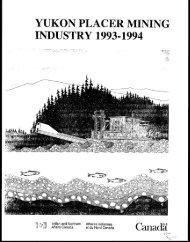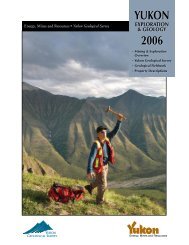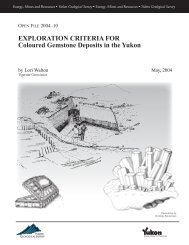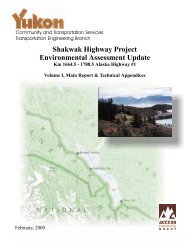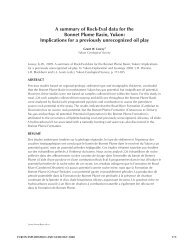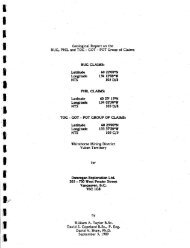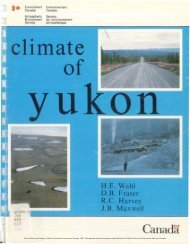Eagle_Plain_matting_..
Eagle_Plain_matting_..
Eagle_Plain_matting_..
You also want an ePaper? Increase the reach of your titles
YUMPU automatically turns print PDFs into web optimized ePapers that Google loves.
The original access mat monitoring methods prescribed in the monitoring plans (EBA memo,<br />
dated March 4, 2008‐ Schedule 1) designed for monitoring the full program of drilling at 4 large<br />
area well sites were not entirely applied in this test program at the Camp 204 site because no<br />
operations were in progress on the mats during this static test, so loading or rocking of the mats<br />
did not occur, except for brief traffic by the front‐end loader and a fully‐loaded water truck.<br />
However, the mats were left in place for at least the period required to prepare a drill site and<br />
drill a well and test it, so the effect of mat cover on the vegetation and active layer<br />
temperatures was the principal accomplishment of this Mat Test Application Study.<br />
OBSERVATIONS<br />
Site characterization commenced with a preliminary vegetation survey; 0.5 m of snow was<br />
cleared from an area of approximately 1 square metre, and plant species, condition and<br />
abundance were assessed.<br />
Over the area where the mats were to be installed, packing by snowmobile and tramping by<br />
foot reduced the natural snow depth of 0.5 m to 0.6 m to about 0.1 m to 0.15 m. The site was<br />
then marked out for installation of four (4) mats in sets of 2, with one set to be laid on tamped<br />
snow and the other set to be installed over watered snow.<br />
A small existing trail was used to access the natural area which had been selected to place the<br />
test mats. Additional mats were used on the short access trail to protect the ground during<br />
placement of the test access mats. Figure 4 shows the final access mat placement locations.<br />
After site preparation, mat placement sites were located and shallow holes were drilled into soil<br />
and permafrost for placement of EBA thermistor cables. Thermistor cables were placed in PVC<br />
tubing istalled into the boreholes and sealed to prevent water entry from above. Watering of<br />
the “ice‐road” simulation mat set was then carried out, and consisted of application of about 25‐<br />
30,000 litres by hose from the <strong>Eagle</strong> <strong>Plain</strong>s Hotel water truck. Mat placement was directed by<br />
Peter Moignard of NCY on April 8 and 9, 2008. A Caterpillar 966 wheel loader with a fork<br />
attachment was used for mat placement and removal. For mat transport and placement, chains<br />
attached to fixed rings on the mats were hooked by the loader for transport and vertical<br />
placement. Repositioning of mats was done with vertical movement; in order to reduce the<br />
probability of ground disturbance during placement of the access mats. A small careful<br />
horizontal slide of the mats on the snow or ice to abut them was necessary, but no gouging of<br />
the ground surface was permitted.<br />
Photographs are included after Figure 4 (at the end of this written report) to illustrate the mat<br />
placement layout, operations to install and remove the mats, thermistor installation locations<br />
and vegetation response to <strong>matting</strong>.<br />
9



